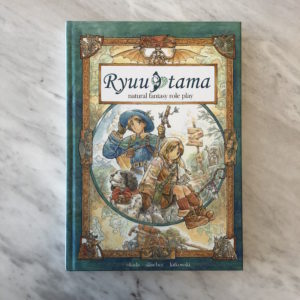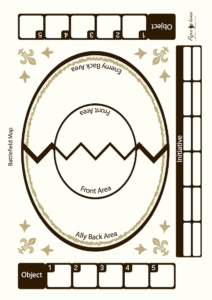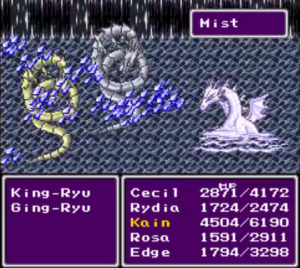Following are a few miscellaneous mechanical ideas gleaned from Ryuutama which may be worth adapting or hacking into your D&D-alike edition of choice.
Initiative is AC
 At the start of combat in Ryuutama, each player character rolls initiative, which is DEX + INT. Recall that abilities are dice, with d6 representing average, so this roll is something like 2d6 or d6+d8. The value obtained both determines order of action and defense value (basically, AC). An equipped shield provides a minimum defense value (7 for small shields and 9 for large shields). This makes both initiative and shields more influential without contributing to numerical inflation (as happens with the arms race between AC bonus and attack bonus for many versions of D&D).
At the start of combat in Ryuutama, each player character rolls initiative, which is DEX + INT. Recall that abilities are dice, with d6 representing average, so this roll is something like 2d6 or d6+d8. The value obtained both determines order of action and defense value (basically, AC). An equipped shield provides a minimum defense value (7 for small shields and 9 for large shields). This makes both initiative and shields more influential without contributing to numerical inflation (as happens with the arms race between AC bonus and attack bonus for many versions of D&D).
In addition to equipping a shield, player characters can use an action to re-roll initiative, taking the new result if it is better. So, a bad initiative roll does not spell doom, though it can slow a player character down (which seems appropriate for initiative).
Initiative also controls retreat
Even among those woke to the virtues of morale checks, in my experience it is easy to slip into fighting to the last combatant. This may play into the reasons for retreat rules either being somewhat complex or perhaps just untested. In any case, the Ryuutama approach here is both simple and surprisingly harsh when followed to the letter, given the suggested heartwarming tone. The rule is that travelers can retreat if the sum of their initiative values is equal to or higher than the sum of enemy initiative values. This means that once enemies gain an advantage, it may become very difficult, or even mathematically impossible, to run away.
That math may be less than ideal, depending on your intention for combat dynamics, but I like the idea of using initiative to manage retreats. Another, slightly more flexible approach for Ryuutama along similar lines—that I may use the next time I run Ryuutama—would be to have the entire party make a new group initiative check to determine whether running away is possible. This would hold out a sliver of hope, even if several travelers were down and the sum of enemy initiative values was high.
This is even easier to hack into another game if using side-based d6 initiative, though it is a bit more random. When the player characters win initiative they can simply declare retreat and it happens, as long as there are no obvious fictional constraints such as a bridge being out. Similarly for monsters. Then, if one side or the other wishes to pursue, chase rules would come into play.
Battlefield abstraction

Ryuutama battlefield (PDF here)
As in many classic JRPG video games, combatants are either in the front or rear rank. Combatants in the front rank may be targeted with either melee or ranged attacks while combatants in the rear rank may only be targeted with ranged attacks. Any area effects attack all combatants in the front ranks, either allied or opponent. If all the combatants in the front rank are defeated, the remaining combatants in the rear move into the front, meaning that it makes sense to maintain several frontline defenders if possible, though one will hold the line.
This is elegant (and plays nicely based on my limited experience so far). The structure maintains enough tactical complexity to model offensive and defensive fighting without resorting to bonus math; further, it requires minimal bookkeeping. I was originally somewhat wary of the structure feeling artificial and constraining tactical infinity, but in practice our fictional battlefield and the tactical schematic coexisted without conflict. This approach could be lifted verbatim, I think, into a B/X game.
Ability checks draw on two abilities
In Ryuutama, any ability check uses two abilities. In all versions of D&D that I am familiar with, ability checks use only one stat, such as strength. Using two abilities leads to a surprising degree of mechanical richness, however, and would be particularly easy using the ability bonus scale of B/X, which is 13-15 = +1, 16-17 = +2, and 18 = +3. This, two relevant 18 stats yields only a +6 bonus, well within the scope of modern bounded accuracy approaches. This would be most straightforward when using roll high versus DC style ability checks but easy with roll-under checks too (just allow the bonus of one ability to increase the value of the other ability, for purposes of the immediate check).
Condition modulates poison etc
Traditional D&D often uses save or die for poison. This works well enough, but requires some care on the referee side. It is, however, abrupt. Many alternative approaches soften the blow by providing various additional buffers, such as having poison do damage or applying other effects. Generally, this makes poison either a mere distraction or an additional thing to track.
The approach in Ryuutama is to make poison, and other similar conditions, only affect travelers with condition less than or equal to some set value. (Condition in Ryuutama is sort of like mood and travelers re-roll it each day.) The effect of poison in Ryuutama is to decrease strength by one die type. A D&D analogue might be disadvantage to attack rolls and physical ability checks, with the modulating factor probably being HP; for the threshold, something like 25% or 50% max HP might work. Though this certainly makes poison less immediately terrifying than save or die, I kind of like it.


